Origin Genesis Review: Triple Titan Terror
by Ryan Smith on April 23, 2013 9:00 AM ESTLetting Titan Spread Its Wings, Cont
Moving on, let’s take a look at 3 of our most intensive games: Battlefield 3, Far Cry 3, and Crysis 3.

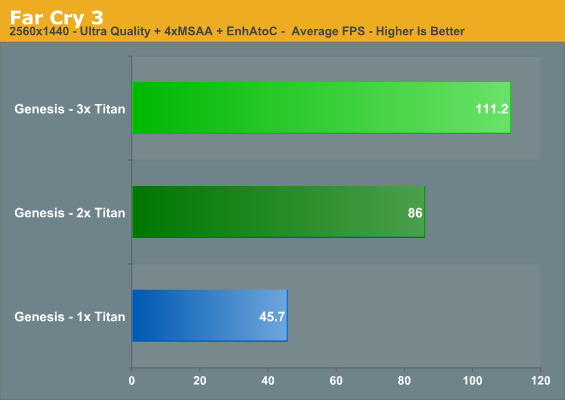
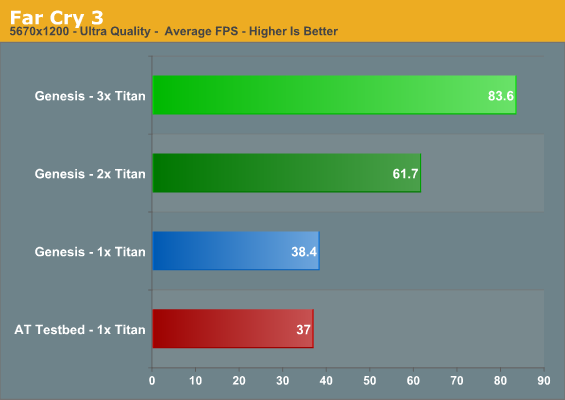
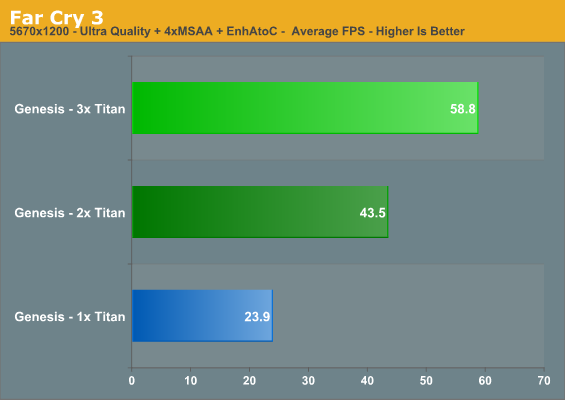
Far Cry 3 is another game that highlights the difficulty in keeping all 3 Titans fed. We have to go to 5760 before a tri-SLI setup isn’t being held back by the CPU. Once we’re there however, additional Titans make a clear difference. At least 2 are required to keep average framerates above 60fps at 5760 without anti-aliasing, and with the AA cranked up even 3 Titans can’t quite crack 60fps. This may be for the best though; for some reason the input lag at 5760 with 3 Titans is especially bad, and this is likely a further artifact of Far Cry 3’s quirks.
At the very least scaling is once again fairly good. At 5760 with AA moving from 1 to 2 Titans improves performance by 82%, and 2 to 3 Titans by another 35%.
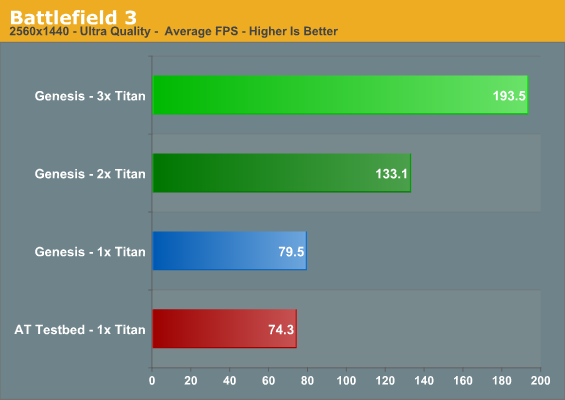
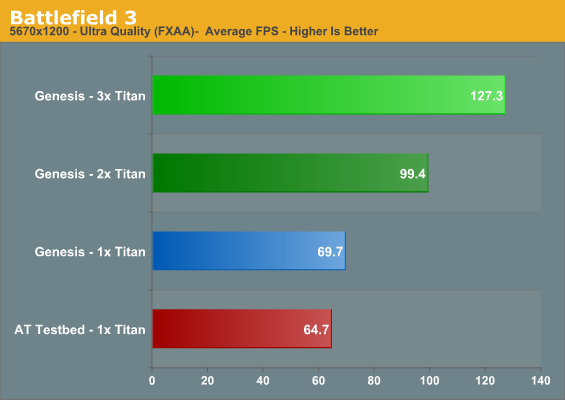
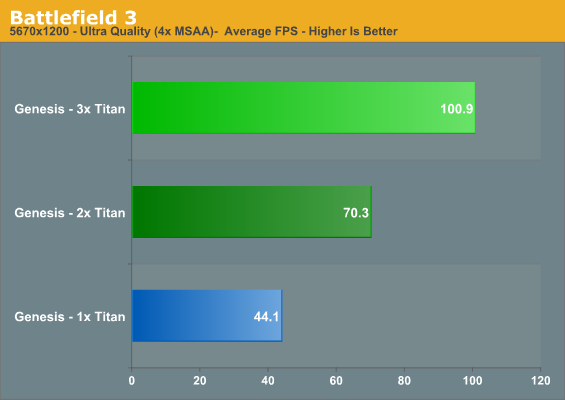
Battlefield 3 isn’t appreciable CPU limited, but it does present something of a scaling issue for Titan. Scaling with 1 display is only 67% for the 2nd Titan, and 45% for the 3rd. And with multiple displays at 5760 with MSAA that becomes 59% and 43% respectively. Oddities aside of scaling being relatively better with the 3rd Titan than the 2nd, even with MSAA we’re seeing an average of 70fps with 2 Titans at 5760, so minimum framerates are still above 30fps. So the practical advantage of the 3rd Titan is limited to minimum framerates, or otherwise doing 120Hz gaming.
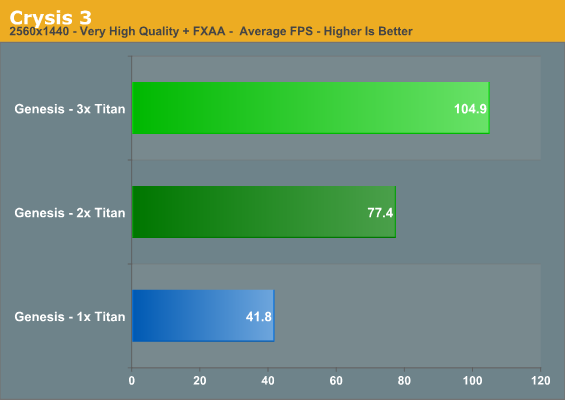
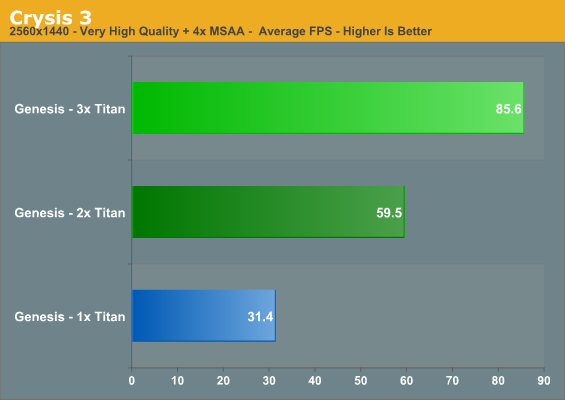
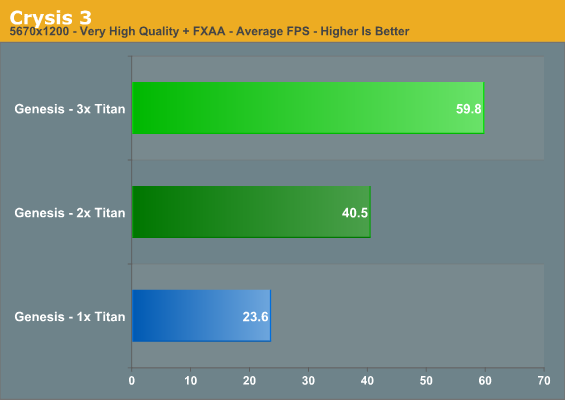
Finally we have Crysis 3, which is first being used here before rolling it into our larger benchmark suite. Taken from the intro level (Post-Human), Crysis 3 was meant to kill GPUs and it shows. 1 Titan can’t break 60fps at 2560 even with FXAA, and 2 Titans are just short if we add MSAA. Move to 5760, and even 3 Titans won’t break 60fps with FXAA. So while the rest of the games in our suite need multi-monitor resolutions to really take advantage of a tri-SLI setup, even 1 2560 monitor can drag a tri-SLI setup back down to earth when it comes to Crysis 3. Even if it’s not game of the year, just as in past years Crysis 3 will move high-end video cards; of that there’s no doubt.
Looking at Titan scaling again, Crytek and NVIDIA have clearly done their homework for single-monitor resolutions. At 2560 with MSAA scaling is 89% from 1 card to 2, and 44% from 2 cards to 3. Unsurprisingly, scaling does taper off at 5760 due to the performance hit of keeping multiple display buffers across multiple cards organized. 1 card to 2 cards is just 72% here, but adding a 3rd card adds another 47% in performance.
Across our 6 games we can see that 3 Titans generally pays off, but a big part of this is using resolutions and settings that can shift as much of the burden onto the GPU as possible. With the exception of Crysis 3 almost everything plays fine on just 2 Titans, with the 3rd Titan necessary to hit 5760x1200 with the best quality settings. On the other hand the fact that even Crysis 3 is almost at 60fps at 5760 with everything short of MSAA turned up is quite a change of pace. NVIDIA told us they wanted tri-SLI Titan to be a no-compromise gaming setup, and indeed they’ve delivered on that.
The only way we’d be able to push a tri-SLI Titan setup harder would either be to use a 2560x1440 surround setup – which admittedly isn’t outside the realm of possibility when we’re talking about pairing it with a $9000 computer – or otherwise going outside the lines and using SSAA on the titles that support it. It may come off as hyperbole, but “I have 3 monitors and the Genesis still isn’t slow enough” was a very real problem putting this article together. To that end it’s surprising that we weren’t CPU limited more often than we were; it’s still a concern, but for the most part in surround gaming the CPU can stay ahead of the GPU, at least if it’s as heavily overclocked as the Genesis’ 4.9GHz SNB-E.










63 Comments
View All Comments
UltraTech79 - Tuesday, April 30, 2013 - link
All these idiots did was slap in the most expensive shit they could find. No real thought put into this. No thought put into how fucking loud this thing is or how usable. Its just one big circlejerk. I should charge them 100$ for wasting my time looking at it.Yoiu might think "yeah you say all that but if you got one youd be happy" Yeah, realistically Id be very happy, becuse Id sell the POS for 7-8k$ even if its individual parts and build a better PC for 2k and save the rest.
DPOverLord - Tuesday, June 25, 2013 - link
What are the thoughts on this driving a surround 27 / 30" 7680 x 1600 system? Are two titans enough or do you actually need 3?healingshoes - Friday, July 12, 2013 - link
something - ok a bunch of things - about this system build bother me... a lot.a lot a lot.
actually more than a lot a lot lol...
why use this "always on" power sucking money sink water cooling system, when the Titan SLI has fan control sensors so sensitive that it can respond to microscopic changes in environment?
and this cooling system, as the reviewer mentions, packs up all the free volume inside the casing, meaning the Titan's own cooling system is being completely sabotaged by origin's water cooling.... it doesnt have nearly enough internal volume of air to do what it's intended to do.
also, it's windows 7 not windows 8, so it has ZERO memristor pathing optimization, or green power consumption reductions, or auto fan control.
on top of all that, i have to look at that water cooling being stuffed in there, creating insufficient airflow for the titan's on board vents and fan, and what comes to mind is that the design of the air intakes and fan - look at the fan back casing on the titan... it;s an acoustic bouncer and amplifier. why would you AMPLIFY fan noise?
there can only be one reason for that. the shape of the rotor blades must be designed to combine the fan's low end air rumble with the air intake sound to create a harmonic which gives you SIGNAL CANCELLATION of your high end fan motor noise.
but without sufficient air volume inside the case, the morons turned signal cancellation into amplified motor noise because sound pitch gets altered, to a higher tone, and AMPLIFIED in a vacuum or partial vacuum. so instead of two layers of noise and two cancelled layers of noise, you end up with the 4 normal noise layers PLUS a harmonic which shouldnt be there.
and this reduced pressure from the fans not having enough air volume gives you a whole other problem in terms of creating more heat, BECAUSE WATER BOILS AT A LOWER TEMPERATURE AT LOWER PRESSURE!!!
I don't know what genius went and did this and for what reason, and I don't know how someone with this little basic knowledge of physics gets a job building high end computer systems, but I do know he sabotaged the performance tests. Badly.
To me, it seems like his water cooler was the noise and heat and power consumption problem, AND the 3rd card underperformance problem.